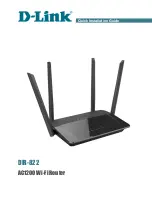
134
RackSwitch G8000: Application Guide
ACL Metering and Re-Marking
You can define a profile for the aggregate traffic flowing through the G8000 by
configuring a QoS meter (if desired) and assigning ACLs to ports. When you add
ACLs to a port, make sure they are ordered correctly in terms of precedence.
Actions taken by an ACL are called
In-Profile
actions. You can configure additional
In-Profile and Out-of-Profile actions on a port. Data traffic can be metered, and
re-marked to ensure that the traffic flow provides certain levels of service in terms of
bandwidth for different types of network traffic.
Metering
QoS metering provides different levels of service to data streams through
user-configurable parameters. A meter is used to measure the traffic stream against
a traffic profile, which you create. Thus, creating meters yields In-Profile and
Out-of-Profile traffic for each ACL, as follows:
•
In-Profile
–If there is no meter configured or if the packet conforms to the meter,
the packet is classified as In-Profile.
•
Out-of-Profile
–If a meter is configured and the packet does not conform to the
meter (exceeds the committed rate or maximum burst rate of the meter), the
packet is classified as Out-of-Profile.
Using meters, you set a Committed Rate in Kbps (multiples of 64 Mbps). All traffic
within this Committed Rate is In-Profile. Additionally, you set a Maximum Burst Size
that specifies an allowed data burst larger than the Committed Rate for a brief
period. These parameters define the In-Profile traffic.
Meters keep the sorted packets within certain parameters. You can configure a
meter on an ACL, and perform actions on metered traffic, such as packet
re-marking.
Re-Marking
Re-marking allows for the treatment of packets to be reset based on new network
specifications or desired levels of service. You can configure the ACL to re-mark a
packet as follows:
•
Change the DSCP value of a packet, used to specify the service level traffic
receives.
•
Change the 802.1p priority of a packet.
Using DSCP Values to Provide QoS
The switch uses the Differentiated Services (DiffServ) architecture to provide QoS
functions. DiffServ is described in IETF RFCs 2474 and 2475.
The six most significant bits in the TOS byte of the IP header are defined as DiffServ
Code Points (DSCP). Packets are marked with a certain value depending on the
type of treatment the packet must receive in the network device. DSCP is a measure
of the Quality of Service (QoS) level of the packet.
The switch can classify traffic by reading the DiffServ Code Point (DSCP) or IEEE
802.1p priority value, or by using filters to match specific criteria. When network
traffic attributes match those specified in a traffic pattern, the policy instructs the
Содержание RackSwitch G8000
Страница 1: ...RackSwitch G8000 Application Guide...
Страница 2: ......
Страница 3: ...RackSwitch G8000 Application Guide...
Страница 16: ...16 RackSwitch G8000 Application Guide...
Страница 22: ...20 RackSwitch G8000 Application Guide...
Страница 23: ...Copyright IBM Corp 2011 21 Part 1 Getting Started...
Страница 24: ...22 RackSwitch G8000 Application Guide...
Страница 54: ...52 RackSwitch G8000 Application Guide...
Страница 55: ...Copyright IBM Corp 2011 53 Part 2 Securing the Switch...
Страница 56: ...54 RackSwitch G8000 Application Guide...
Страница 92: ...90 RackSwitch G8000 Application Guide...
Страница 94: ...92 RackSwitch G8000 Application Guide...
Страница 144: ...142 RackSwitch G8000 Application Guide...
Страница 145: ...Copyright IBM Corp 2011 143 Part 4 Advanced Switch ing Features...
Страница 146: ...144 RackSwitch G8000 Application Guide...
Страница 148: ...146 RackSwitch G8000 Application Guide...
Страница 182: ...180 RackSwitch G8000 Application Guide...
Страница 184: ...182 RackSwitch G8000 Application Guide...
Страница 212: ...210 RackSwitch G8000 Application Guide...
Страница 258: ...256 RackSwitch G8000 Application Guide...
Страница 286: ...284 RackSwitch G8000 Application Guide...
Страница 294: ...292 RackSwitch G8000 Application Guide...
Страница 298: ...296 RackSwitch G8000 Application Guide...
Страница 310: ...308 RackSwitch G8000 Application Guide...
Страница 311: ...Copyright IBM Corp 2011 309 Part 7 Network Management...
Страница 312: ...310 RackSwitch G8000 Application Guide...
Страница 320: ...318 RackSwitch G8000 Application Guide...
Страница 332: ...330 RackSwitch G8000 Application Guide...
Страница 334: ...332 RackSwitch G8000 Application Guide...
Страница 345: ...Copyright IBM Corp 2011 343 Part 9 Appendices...
Страница 346: ...344 RackSwitch G8000 Application Guide...
Страница 357: ...Copyright IBM Corp 2011 Appendix C Notices 355 Taiwan Class A compliance statement...
Страница 358: ...356 RackSwitch G8000 Application Guide...
















































